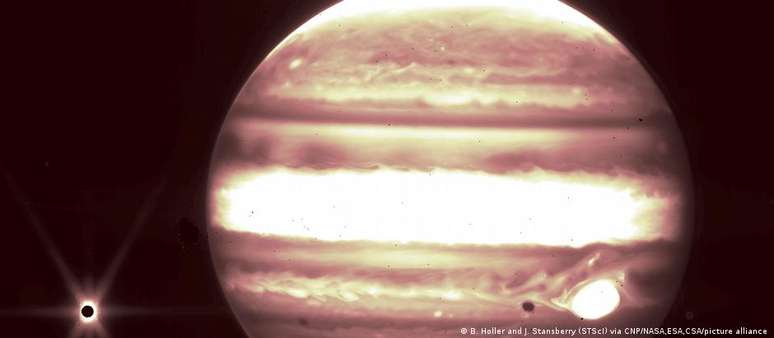The European Space Agency probe will explore three of Jupiter’s moons, with the aim of finding out more about the environment of the largest planet in the solar system and whether there is a possibility of life on one of its satellites. ) will launch the mission dubbed Juice on Thursday (04/13), with the launch of a probe to explore three of Jupiter’s icy moons.
The Jupiter Icy Moons Explorer (Juice) space probe will be launched from the Kourou center in French Guiana and will fly to the moons Ganymede, Europa and Callisto with the aim of “characterizing them as planetary objects and possible habitats”, according to reports from l ‘ESA. In other words, the intention is to know if there has ever been life or if it is possible that there is life on these three satellites of Jupiter.
Juice is a research with new aspects. The probe, which will be launched on an Ariane 5 rocket, will be the first to change course from the orbit of a planet – Jupiter – to that of one of its moons. In addition, the spacecraft will also be the first to orbit a moon other than Earth’s. The mission has an approximate cost of 1.6 billion euros, equal to 8.7 billion reais.
Juice will carry several high-tech systems on board, including “the most powerful instruments for remote sensing, geophysical observations and local environment sensing ever sent to the outer Solar System,” according to ESA.
Although the mission is led by ESA, it has extensive international collaboration. NASA contributed one of the instruments, a UV imaging spectrograph. Japan’s space agency JAXA contributed hardware used in various instruments aboard the spacecraft. Israel’s space agency ISA has supplied the hardware needed for a radio science experiment.
If all goes according to plan, Juice will arrive at Jupiter in July 2031 and make 35 flybys over the three moons through November 2034. The spacecraft is then expected to enter the orbit of the moon Ganymede, where it will remain until December 2035 to gather intelligence. .
Jupiter, the largest planet in our Solar System
Jupiter has 95 moons in its orbit. It is the largest in our Solar System and twice as massive as all other planets combined.
As NASA puts it, “If Earth were the size of a U.S. dime, Jupiter would be the size of a basketball.”
Jupiter has a powerful magnetic field and part of ESA’s mission is to find out how this affects the icy moons that surround the planet. What scientists already know is that the magnetic field moves gas between Jupiter’s moons. The sulfur and oxygen released by volcanoes on the moon Io reach the three ice moons that Juice will explore. The goal is to understand how this process works.
The moons at the center of the Juice mission
The three icy moons of Jupiter that the Juice spacecraft will explore (Europa, Ganymede and Callisto), as well as the moon Io, were discovered by the Italian astronomer Galileo Galilei in 1610 and are known as the four “Galileo Moons”. They were the first objects found in our solar system to orbit a celestial body that was neither the Sun nor the Earth.
Ganymede, the primary target of the Juice mission, is the only moon in our Solar System that generates its own magnetic field. It is not only the largest moon of Jupiter, but also the largest in the entire Solar System, with a diameter of 5,268 kilometers and a metallic core composed of a heavy ferrous liquid. Its subterranean ocean is believed to contain more water than all of Earth’s oceans combined.
Callisto is Jupiter’s second largest moon, and ESA scientists hope that by orbiting it, Juice will glean insights into what the environment around Jupiter was like in the planet’s early days. The moon is made up of equal parts rock and ice and may have a subsurface liquid ocean, located at depths that can exceed 100 kilometers.
Europa, on the other hand, is slightly smaller than Earth’s moon and possibly hosts vast subterranean oceans. It consists mainly of silicate rock and has an ice crust. Juice scientists suspect Europa may be releasing water vapor into space via plumes and geysers. Among the main objectives of the mission is to find out if there are biological signatures and pockets of water, i.e. signs of life, on the moon Europa.
Jupiter’s challenging environment
The Juice vessel will operate in extreme conditions. The area around Jupiter and its moons is one of the most intensely radiant environments in our Solar System. The temperature around the gaseous planet is -230ºC, a vast difference from the scorching 250ºC that Juice will have to endure when it flies past Venus on its journey to Jupiter.
The researchers behind Juice hope the mission will be able to answer a variety of questions about Jupiter’s atmosphere, its magnetic field, and how these factors interact with each other and affect the planet’s moons.
The hope is that the answers to these questions will help scientists better understand the fundamental physics of planetary environments and eventually discover whether life on one of Jupiter’s moons is possible.
Source: Terra
Rose James is a Gossipify movie and series reviewer known for her in-depth analysis and unique perspective on the latest releases. With a background in film studies, she provides engaging and informative reviews, and keeps readers up to date with industry trends and emerging talents.






